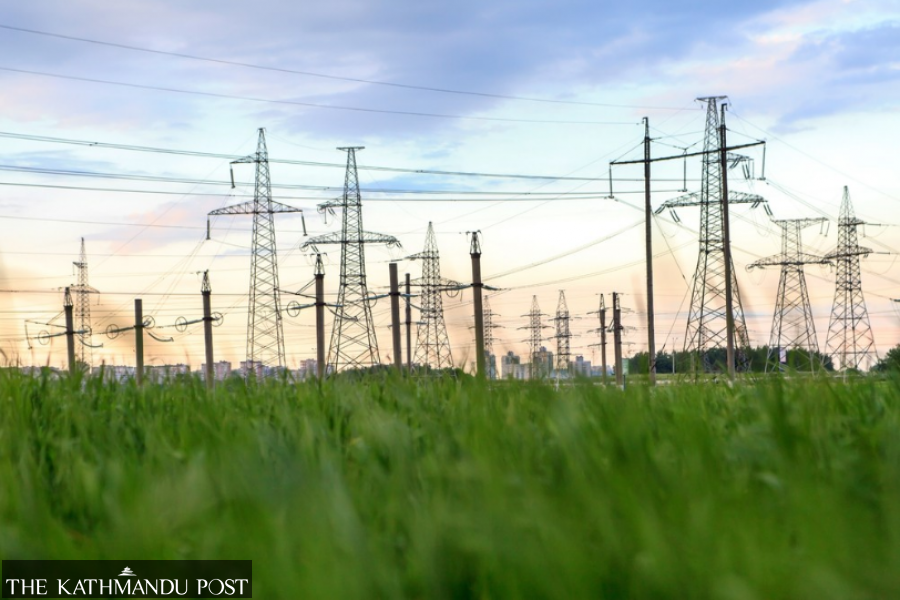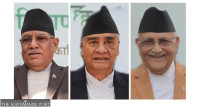National
World Bank pulling out of transmission line projects shows challenges for MCC
Land acquisition for transmission towers and the right of way are major hurdles, which must be settled before the five-year US grant enters into force, officials say.
Prithvi Man Shrestha
The World Bank’s decision to discontinue its aid for two transmission line projects—400kV Hetauda-Dhalkebar-Inaruwa and 220kV Hetauda-Bharatpur-Bardaghat—amid continued delays in their completion has brought to the fore, once again, the challenges in constructing energy infrastructure in the country.
Officials at the Nepal Electricity Authority (NEA) say the international financing institution was forced to discontinue its engagement in the projects, after they could not be moved forward despite repeated deadline extensions.
According to officials, the global lender pulling out of the projects at a time when Nepal is set to construct transmission lines under the Millennium Challenge Corporation Nepal Compact, which was ratified just last week after years of delays, comes as a major cause for concern.
“There is hardly any transmission line project in Nepal which has not faced hindrances,” said Dirghayu Kumar Shrestha, chief of the Transmission Directorate at NEA. “Not even a single project has been completed without time and cost overruns. The main problems that transmission line projects face are land acquisition, forest clearance and the right of way.”
Officials at the Millennium Challenge Accounts-Nepal (MCA-Nepal), a special purpose vehicle formed to implement the projects under the $500 million MCC grant, admit that there are issues in Nepal when it comes to transmission line projects.
MCC is a time-bound aid programme, and projects under it must be completed in five years from the date of its entry into force. “If we cannot spend the budget allocated by the MCC within five years, we cannot spend any remaining budget from the MCC,” said Khadga Bahadur Bisht, executive director of MCA-nepal.
Under the MCC compact, a 315km double circuit 400kV transmission line will be constructed. Five segments of transmission lines to be built are—New Butwal-India Border (18km), New Butwal-New Damauli (90km), New Damauli-Ratmate (90km), Ratmate-New Hetauda (58km), and Ratmate-Lapsephedi (59km).
Once completed, these infrastructures are expected to provide a vital missing link for power projects of different river basins to the existing high-voltage grid. These power lines are also expected to help Nepal export power to India and beyond.
The MCA-Nepal has so far acquired land for building a substation at Ratmate of Nuwakot. Other substations will be built at New Damauli of Tanahun and New Butwal of Rupandehi.
According to Bisht, the Nepal government has so far spent Rs1.42 billion on acquiring the land for the Ratmate substation. The compensation rate was fixed in January 2020, and the MCA-Nepal has acquired 398 ropanis (20.25 hectares) of land. Land acquisition for other substations has been put on hold since April 2020 after Covid-19 hit the country early that year.
Bisht told the Post last month that no new process was started for land acquisition amid uncertainty over MCC ratification. Acquiring land for two other substations, however, will not be a problem for the MCA-Nepal as they will be built on the land owned by NEA.
Officials at NEA say land acquisition for transmission towers and getting right of the way for transmission wires would be the biggest challenge.
“Acquiring land for transmission towers and the right of way for transmission lines are difficult because they cover several districts. And there has been a tendency among locals to create problems,” said Shrestha.
According to him, getting the right of way for transmission lines is one major challenge.
“Land owners don’t get full compensation for the right of way,” said Shrestha. “And the value of land right under transmission wires decreases sharply because such land cannot be used for any purpose other than farming. Such land cannot be put as collateral in banks for loans. Hence, people often do not want to provide the right of way.”
According to him, NEA has so far been providing a compensation of a maximum 20 percent of the actual value of the land coming under such transmission lines.
The transmission lines under the MCC grant will pass through 30 municipalities in 10 districts. As many as 856 towers need to be constructed. Taking cue from the problems faced by other transmission line projects, the MCA-Nepal has an uphill task, officials say.
The World Bank discontinued its funding in November last year for the two transmission lines, according to the NEA.
Before withdrawing its funding, the World Bank had extended the deadline several times. Obstructions from locals and legal cases against the projects, however, led to continued delays, said officials.
“As a result, the World Bank was forced to pull out of these projects,” said Shyam Kumar Yadav, chief of the Nepal-India Electricity Transmission and Trade Project under which these transmission line projects are being implemented. “After extending the last deadline till October last year, the donor agency decided to discontinue funding.”
The two projects had started in 2011 and were initially supposed to be completed by 2016.
The Hetauda-Dhalkebar-Inaruwa 400kV line is currently the only high-capacity project under construction for domestic power transmission. Dhalkebar-Muzaffarpur is the only completed project with the capacity of 400kV, but it is being used for export and import of electricity between Nepal and India.
“The completion of Hetauda-Bharatpur-Bardaghat power line was delayed because the residents of Dumkibas in Nawalparasi did not allow construction of even two towers,” said Yadav.
In April last year, local residents filed a petition at the Supreme Court against the planned construction of transmission towers. The court issued an interim order and the construction plan was stalled.
“Due to the delay in forest clearance in the Chitwan National Park area, construction failed to move ahead in the Hetauda-Bharatpur section,” said Shrestha.
According to the NEA, a new Environment Impact Assessment had to be conducted in this area because the number of trees to be felled increased over time. “Due to the delay in project implementation, shrubs also grew to become trees,” said Shrestha.
The 400kV Hetauda-Dhalkebar-Inaruwa project also faced a similar fate.
“Local people obstructed construction of around 40-42 towers in some locations,” said Yadav.
According to him, locals obstructed NEA’s effort to construct towers in Hatiya of Makawanpur, Jiyajor of Lalbandi Municipality in Sarlahi and the Padariya area of Lahan Municipality in Siraha.
Sarita Giri, a politician and former minister, had filed a petition at the Supreme Court in 2019 demanding change in the route of the transmission line in the Padariya area of Siraha. The Supreme issued an interim order.
“The problem is that even the court does not conduct timely hearings. No hearing has been conducted in both court cases yet,” said Yadav.
The World Bank had pledged $138 million (around Rs16.85 billion) for the two projects and the overall project cost was estimated at Rs25 billion including counterpart funding from the Nepal government, according to the project office.
“As much as Rs13 billion has been spent so far. Since the World Bank has now stopped funding, the government needs to bear all the remaining costs,” said Yadav.
Yadav also shared a bitter experience of the 220kV Khimti-Dhalkebar transmission line project, which he had handled. The Khimti-Dhalkebar project started in 2004 but was completed only in 2018 after prolonged compensation dispute brought up by locals in Sindhuli, said Yadav.
The under-construction 132kV Thankot-Chapagaun-Bhaktapur transmission line has also been facing never-ending obstructions from locals. The project is intended to strengthen the Kathmandu Valley's power supply system. It has been a work in progress since 2004 with the residents of Lalitpur unwilling to give up their land and provide the right of way at the proposed rates.
Residents are demanding compensation equal to the land value—or 100 percent—for easement rights, while the compensation policy says they will get 10 percent.
“Locals from Harisiddhi, Lagankhel and Khokana have not allowed us to construct the transmission line,” said Shrestha. “Had the project been implemented whenever the compensation was fixed in early years, the project would have been completed,” said Shrestha. “Now the value of the land has skyrocketed. Why will the locals agree to the compensation package determined long ago?”
According to a study by the Nepal Rastra Bank, land value in Bagmati Province where Kathmandu Valley lies has gone up rapidly in recent years. Average prices of real estate (land and houses) increased by as much as 16.33 percent in fiscal year 2019-20 and 18.26 percent in the first nine months of 2020-21 based on valuations made by the banks, according to the ‘Real Estate Survey Report-2021.’
Implementation of the 220kV Marsyangdi-Matatirtha Transmission line project is also facing hurdles from locals in Dhading for the last two years. “Locals have not let us build two towers there,” said Shrestha.
Change of route for transmission lines has been a common demand of local residents, but the electricity authority is not in a position to address that.
According to Shrestha, if the power monopoly accedes to such demands, it may set a precedent and people from other areas will start demanding similar treatment for them.
“We have been making efforts to address their demands by hiking the compensation or by providing some other incentives,” he said.
The 132kV double circuit Solu Corridor transmission line offers yet another example of how projects face massive hurdles in Nepal. It came into operation only in December last year after years of delays. Local’s obstruction at Katari, Udayapur had delayed construction works.
The 132kV Singati-Lamosangu transmission line also faced hurdles from locals but has now been completed after 11 years. The 220kV Trishuli-Matatirtha project was completed over a year ago, according to the NEA.
Officials say some other factors, like under-peformance by contractors, too contribute to delays but the main issues are land acquisition and the right of way.
“The problems we have faced over the years must be taken into consideration as the MCC compact is going into implementation soon,” said Shrestha.
Himesh Dhungel, the first country head of the MCC Nepal Programme, who served from October 2015 to December 2017, told the Post last week that potential hurdles in land acquisition should be properly examined before setting a date for the agreement’s entry into force.
Officials at the MCA-Nepal also acknowledge the possible challenges.
“Our plan is to acquire land for the majority of transmission towers before the date for the compact’s entry into force is set,” said Bisht. This, according to him, will reduce the risk of the MCC fund being returned.
He said that the MCA-Nepal is planning to start the processes of issuing construction tender and land acquisition for towers simultaneously.
“Our plan is that the MCC Compact will be taken into force only after selecting the contractor. The contractor will be working on building the foundation for the majority of towers while we will be negotiating with the locals for the remaining towers.”
Past experiences also show obstructions but in certain pocket areas. However, officials are worried as some political forces have been warning against the MCC’s implementation. Some senior leaders of major parties too oppose the compact.
“Involvement of local politicians and representatives of some non-government organisations in obstructing transmission line projects creates problems more often,” said Yadav.




 5.8°C Kathmandu
5.8°C Kathmandu










%20(1).jpg&w=300&height=200)




